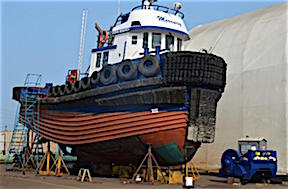The following is text of a news release from the Transportation Safety Board of Canada (TSB):
(VANCOUVER, British Columbia) — The Transportation Safety Board of Canada (TSB) has released its investigation report (M17P0244) into a July 2017 occurrence during which the tug Ocean Monarch made bottom contact while transiting the Princess Royal Channel south of Kitimat, British Columbia. The report underlines the need to effectively manage the risk of fatigue in the marine industry.
On July 9, 2017, at 4:36 am Pacific Daylight Time, the tug Ocean Monarch, with three crewmembers on board, made bottom contact while towing the loaded cement barge Evco No. 15. No pollution or injuries were reported, but the tug's hull, starboard propeller and nozzle were damaged. After a damage assessment and actions taken to prevent fuel from leaking, the tug resumed its voyage to Kitimat, B.C., using the port engine. It then returned to the Fraser River and a shipyard in Vancouver for repairs.
The investigation determined that the mate, alone on watchkeeping duties, fell asleep while the tug and barge transited on autopilot through the channel's confined waters. At the time of the occurrence, the mate had been on duty for at least eight hours. The master and deck hand were asleep below deck. All navigational alarms were disabled. The mate fell asleep likely as a result of acute fatigue from previous night shifts, chronic sleep disruptions, circadian rhythm desynchronization, combined with the low and monotonous workload in the wheelhouse.
The investigation also found that the tug's operator had no strategies in place to mitigate crew fatigue, despite a previous occurrence in 2011 where fatigue played a role (M11W0091). Given the tug's 24-7 operations, a three-member crew made it challenging, and at times impossible, to maintain two people on the bridge every night while also ensuring the crew was sufficiently rested. If an operator does not have a fatigue management plan and is not required to have one, there is a risk that crews will work while fatigued, increasing the likelihood of an error that leads to an occurrence.
Fatigue management is on the TSB Watchlist 2018 as a multimodal issue. In the marine sector, the board made two recommendations in May 2018 following its investigation into the sinking of the tug Nathan E. Stewart (M16P0378) in British Columbia. The first recommendation (M18-01) calls for mandatory education and awareness training for watchkeepers whose work and rest periods are regulated by the Marine Personnel Regulations to help them identify and prevent the risks of fatigue. The second recommendation (M18-02) calls on Transport Canada to require that vessel owners implement comprehensive fatigue-management plans, tailored specifically for their individual operations.
Following this investigation, the operator installed a navigational watch alarm on the bridge of Ocean Monarch, and ordered that all alarms be enabled and monitored at all times. New safe operating procedures were developed and implemented on the vessel. The Pacific Pilotage Authority revoked the pilotage waiver for the master and required him to become informed of the waiver requirements before reinstating his waiver.
Click here to read the full report.

